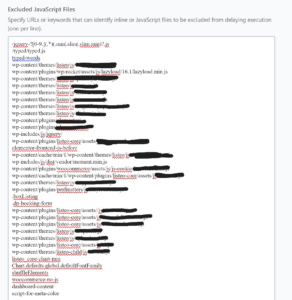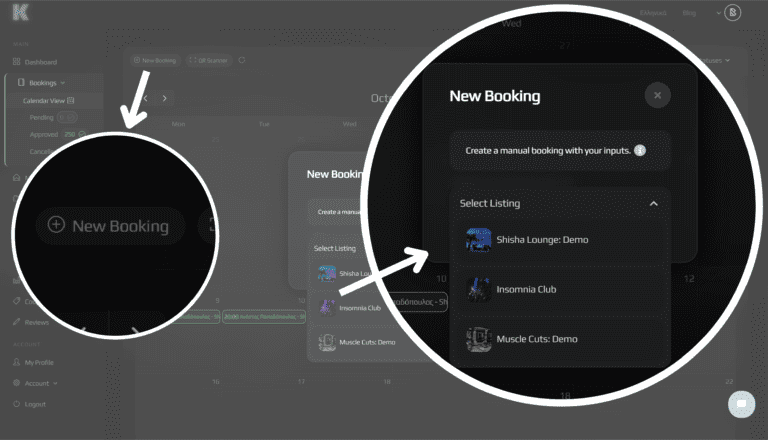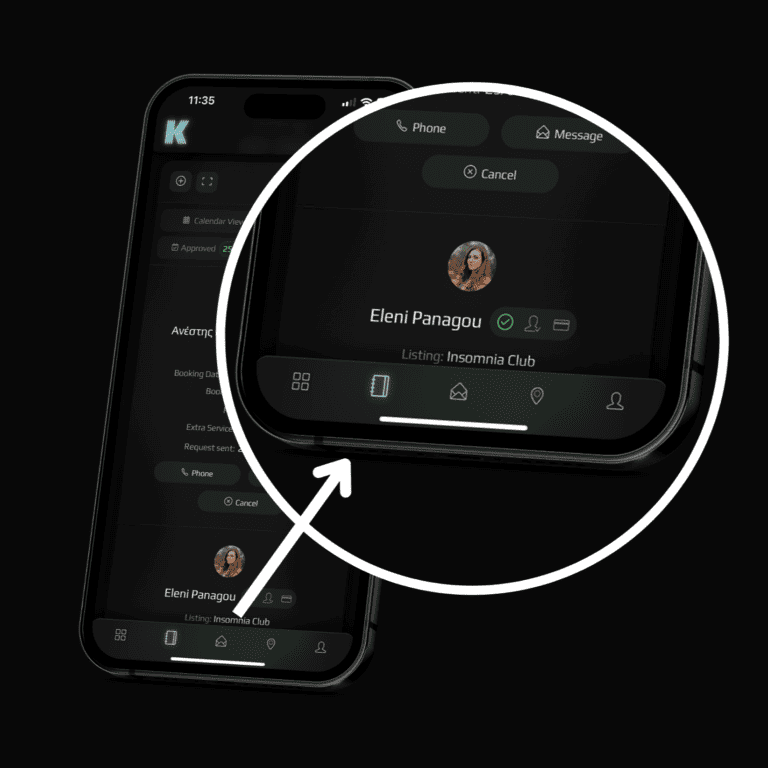Frontend Speed to A+
Accelerating Listeo: From common Tips to Exclusive Speed Secrets
Four years of specialized Listeo work have equipped us with unparalleled speed optimization expertise. While common cache plugins can offer a basic speed improvement, they don’t fully unleash your site’s potential. We dig deeper into your WordPress site’s architecture, applying advanced customizations to tackle speed limitations and supercharge your Listeo platform performance.

Why Does Page Speed Matter?
User Impatience: A Harsh Reality
Three seconds. That’s all the time you have to capture a visitor’s attention on your website. In today’s fast-paced digital world, speed is at the forefront of user expectations. A slow website means users may potentially abandon your site before it even loads, resulting in lost traffic and diminished brand reputation. The repercussions of a slow-loading site are far-reaching and supported by hard data. According to case studies involving giants like Amazon and Google, a mere 1-second delay in page load time can lead to a 7% loss in conversions, 11% fewer page views, and a 16% decrease in customer satisfaction.
When it comes to a specialized business listing directory platform like Listeo, the stakes are even higher. Users expect more from your platform than they would from a typical e-commerce store. They’re not just browsing; they’re booking appointments, reserving tables, and listing their own businesses. A slow site not only tarnishes your reputation but also impacts the probability of new users making bookings or business owners adding their listings. In a world where every second counts, your platform’s speed isn’t just a “nice to have”—it’s a critical factor in your business’s success and longevity.
The Google Impact: Speed as a Ranking Factor
Speed isn’t just about user experience; it’s a key factor in how Google ranks your website which is a serious lead generator for any Listeo site. Google’s search algorithm places significant weight on page speed, expecting that a quick-loading site will offer a better user experience. Google has integrated Core Web Vitals as a critical ranking factor. Core Web Vitals comprise three main elements: Largest Contentful Paint (LCP), First Input Delay (FID), and Cumulative Layout Shift (CLS), each representing a different facet of user experience and must be taken very seriously.
But Google’s assessment of your site’s quality extends beyond just these metrics. If users leave your site quickly due to slow loading times, Google interprets this as a sign of poor user experience, which can negatively impact your SEO rankings. Essentially, Google uses metrics like high bounce rates and short session durations to evaluate user dissatisfaction. As such, speed optimization is crucial not only for improving user experience but also for maintaining strong SEO performance.
The Speed Paradox: Why Most Listeo Sites Lag Behind
Despite Listeo’s well-strucuted and efficient coding, we’ve found that somehow, most Listeo sites—including well-established ones—paradoxically struggle with poor frontend speed. This common oversight led us to investigate the root cause. Following our investigation, we’ve developed a two-tier strategy to address speed bottlenecks. The first tier involves basic optimization tips—standard WordPress practices that can be implemented with cache plugins and some basic customizations. These will set the foundation for your site’s speed but will only get you so far. The second tier is where the magic happens: advanced customizations tailored specifically for Listeo. These techniques have been refined over our four years of concentrated experience on Listeo sites and are designed to elevate your site’s speed to levels unattainable without our secret sauce.
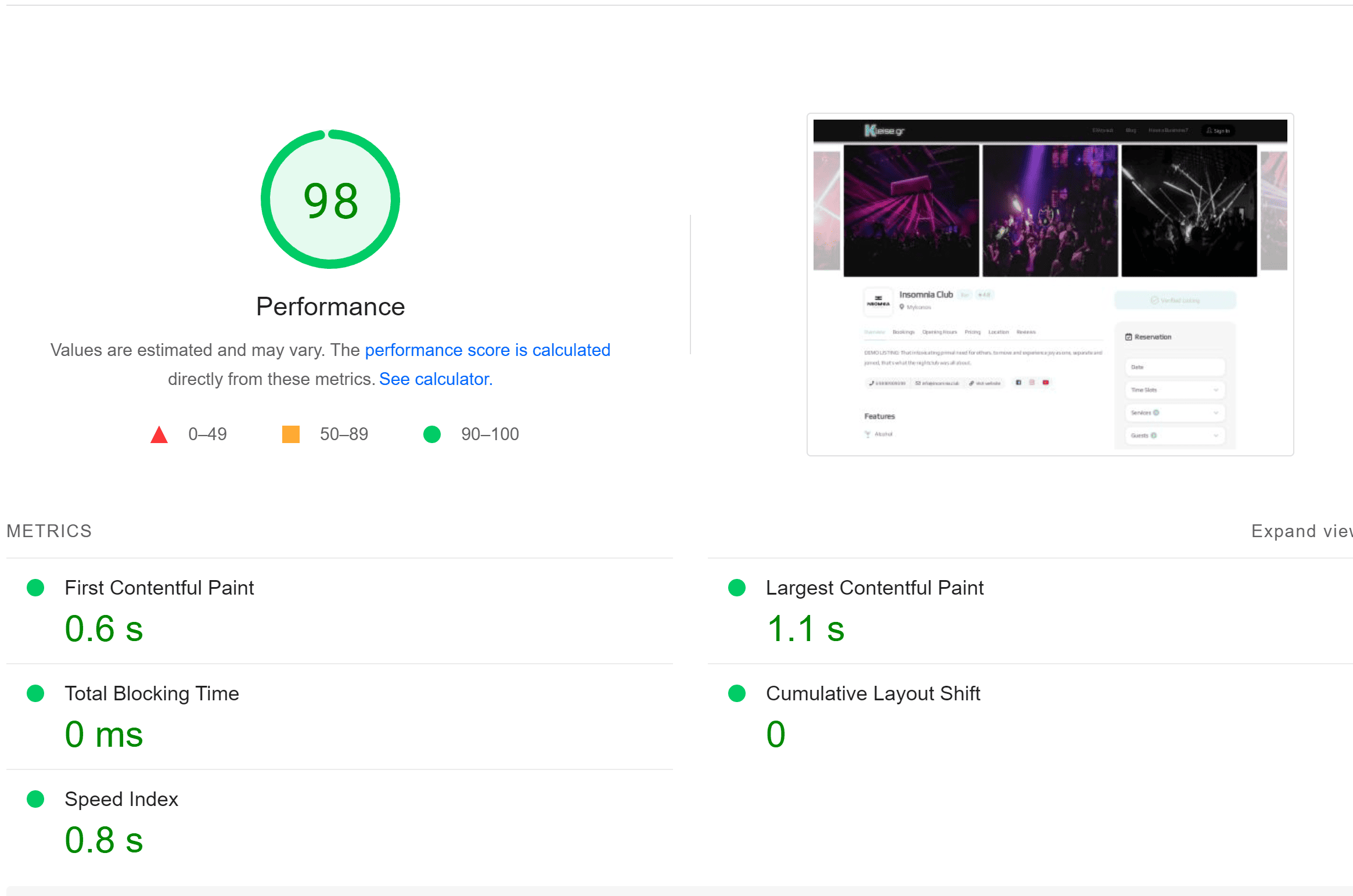

Part 1 : Foundational Speed Improvements
We know that experienced WordPress users have likely encountered these well-known speed optimization tips countless times. If that describes you, feel free to skip ahead to Part 2 for advanced, Listeo-specific strategies. However, if you’re new to the WordPress ecosystem, this section is crucial for you. Our goal is to cut through the generic advice commonly found online and provide you with actionable, foundational practices. These basic but vital optimizations are typically handled by a robust caching plugin. Think of this part as laying the groundwork—it’s essential but only the starting point for truly maximizing your Listeo site’s speed.
Choose a Reliable Hosting Provider
This may sound like a cliché tip, but let's be clear: without a solid hosting foundation, most of your other speed optimization efforts will be hopeless. While hosting isn't the most significant factor for frontend speed—especially after applying caching and CDN—it's crucial for handling dynamic content and Time to First Byte (TTFB), the time taken for server-side rendering before the page is sent to the client.
To put it simply, the quality of your hosting often correlates with its price but still you don't necessarily have to spend on high-end servers costing $200 or more per month. If your site doesn't have hundreds of bookings per day, a mid-range hosting plan in the $30-$50 per month range should suffice for ensuring reasonable frontend speed. On the flip side, avoid budget hosting plans that offer limited resources, like a 1 CPU and 2 GB RAM server; they're ill-suited for Listeo requirements.
While we've set up advanced dedicated server stacks and even multi-server configurations with load balancers on AWS and GCP for clients' large-scale Listeo platforms, we find these setups to be overkill for 99,99% of Listeo sites. Thanks to our in-depth speed optimization and streamlined coding practices, a single VPS from providers like Cloudways, Kinsta, Hostinger, or WP Engine is usually all you need. These providers offer a balanced mix of performance, efficiency, and ease of use, minimizing the need for constant upkeep. We personally host all our sites on Cloudways, capitalizing on their specialized tech stacks optimized for WordPress, the convenience of managed hosting, and the high-performance capabilities of Vultr High Frequency servers.
Utilize a good Caching Plugin
This tip might sound obvious, but its importance cannot be overstated: a caching plugin is essential. In particular, caching plugins are crucial for page caching- one of the many caching layers we will talk about, which significantly speeds up load times for guest visitors. A caching plugin works by generating static HTML pages of your website and storing them on your server. When a user visits your site, the plugin serves these lighter HTML pages instead of the resource-intensive WordPress PHP scripts. This makes your website faster and more efficient.
Apart from the standard page caching utility, a premium caching plugin offers a range of features that can be configured for additional speed gains. These features, while straightforward to implement, are pivotal in enhancing your site's overall speed and performance.
Key Features of a Premium Caching Plugin
✅ Caching of all pages for quick viewing
✅ Mobile visitor caching
✅ Caching for logged-in users
✅ Preloading the cache of pages
✅ Reduction of HTTP requests to speed up load time
✅ Bandwidth optimization through GZIP compression
✅ Applying optimal browser caching headers
✅ JavaScript minification and combination
✅ CSS minification and removal of unused CSS
✅ Lazy loading of images with WebP compatibility
✅ Deferred JavaScript loading and execution
✅ Critical Path CSS generation and deferred CSS loading
✅ Database optimization
✅ WordPress Heartbeat API control
✅ DNS prefetch
✅ CDN and Cloudflare integration
All the features mentioned earlier, and many more, are encompassed in WP Rocket. This is precisely why we've invested so heavily in it and why we encourage all our clients to adopt it as well. When you hire us for speed optimization services, we provide you with a lifetime license for WP Rocket. We've taken it a step further by developing a specialized WP Rocket "helper" plugin exclusively for Listeo. We will specifically code the Listeo x WP Rocket plugin for your site's exact needs and functionalities. Stay tuned for the next section, where we'll break down the advanced optimizations made possible through this custom solution.
Leverage a Content Delivery Network (CDN)
A CDN is another cornerstone in the foundation of website speed optimization. By distributing your site's static files across multiple servers worldwide, a CDN ensures that users access your content from the nearest location, drastically reducing load time. It's not just about speed; a CDN also improves your site's reliability and security by mitigating DDoS attacks and other vulnerabilities.
Why Cloudflare Stands Out
Cloudflare is our go-to choice for a CDN, and for good reasons. Aside from offering a generous free package, Cloudflare boasts the most extensive network of servers worldwide. This ensures that your content is always delivered from a geographically optimal location, providing the fastest and most reliable user experience.
But Cloudflare is more than just a CDN; it's a comprehensive reverse proxy solution with a plethora of features tailored to enhance both speed and security. Below are some of the key Cloudflare features we leverage for Listeo platforms:
✅ Global CDN
✅ SSL/TLS Encryption
✅ Advanced DDoS Protection
✅ Enhanced Web Application Firewall (WAF)
✅ Super Bot Fight Mode
✅ Image Compress, Resizing & Delivering
✅ DNS Management
✅ Cache Purging
✅ Rate Limiting
✅ Argo Smart Routing
✅ Page Shield
✅ CloudFlare APO for WordPress
✅ Cache Reserve
And many more...
Cloudflare's variety of features address nearly every aspect of your site, from speed and security to reliability and beyond. That's why we utilize Cloudflare for all our clients. To make the most out of this robust platform, we've developed advanced customizations specifically designed for Listeo x Cloudflare integration. These custom tweaks further amplify the speed benefits, ensuring your Listeo site performs at its peak.
The Synergy of Cloudflare, Cloudways, and WP Rocket
One of the compelling reasons we advocate for the combination of Cloudflare, Cloudways, and WP Rocket is their seamless integration. WP Rocket offers a Cloudflare add-on, streamlining the connection for additional feature implementation. Even more impressively, Cloudways provides its clients with Cloudflare Enterprise features, usually accessible only to large-scale, international corporations. This is another testament to the power of this triumvirate in optimizing your Listeo site for speed, performance, and security.
By leveraging this integrated trio, you're essentially future-proofing your Listeo platform, ensuring it runs smoothly, loads quickly, and remains secure.
Optimize Images
Images are often the Achilles' heel of website speed, especially on platforms like Listeo, which depend heavily on visual elements. The challenge here is multi-faceted; it's not just about compressing images but also about efficient delivery, preloading, and employing the right formats.
Compressing and Efficient Image Formats
We recommend using ShortPixel for image compression. It reduces file sizes without compromising image quality and automatically converts images to the more efficient WebP format. Specifically, using its Lossy compression setting, ShortPixel reliably reduces image sizes by up to 90% for large files, without a noticeable loss in quality. On average, it achieved a reduction in overall image size across various sites, markedly better than other plugins we've tested. While we recommend ShortPixel based on our experience, if you already have an alternative plugin that you're satisfied with, you should go with it. ShortPixel is our preferred choice, but it's not a make-or-break factor in the optimization process.
Lazy Loading Images
Lazy loading is a technique that delays the loading of images until they are in the viewport, reducing initial load time. WP Rocket, our preferred caching plugin, offers lazy loading functionality out-of-the-box. However, improper lazy loading can have drawbacks.
Preloading and Excluding Critical Images
Critical images, such as the first images of a listing gallery or a website logo, play a significant role in the Largest Contentful Paint (LCP), a Core Web Vital metric used by Google for SEO ranking. Lazy loading such images could negatively impact your LCP score. To avoid this, we use custom hooks and filters to exclude these critical images from lazy loading. Additionally, we employ preloading techniques for these images to ensure they're ready as soon as they're needed.
Customized Lazy Loading
It's important to note that lazy loading is most effective for large, below-the-fold images. For smaller images like logos, badges, and avatars, lazy loading can do more harm than good, leading to a confusing user experience. That's why our custom hooks and filters are tailored to ensure that only the appropriate images are lazy-loaded.
Its worth noting that Cloudflare and other CDN services also offer features that can handle image compression, format conversion to WebP, and lazy loading. However, we generally recommend using in-house plugins like ShortPixel and WP Rocket Lazy-Loading for these tasks. The reason is simple: in-house plugins offer a level of customization that is often necessary for the specific needs of a Listeo site we described before.
In summary, our multifaceted approach to image and video optimization aims to strike the perfect balance between visual richness and speed. By leveraging tools like ShortPixel and WP Rocket, and by employing custom hooks and filters specifically designed for Listeo, we offer a finely-tuned, high-performance user experience.
Certainly, what we’ve covered so far are fundamental speed optimization strategies that can largely be implemented through plugins and third-party services and are extensively covered in countless articles, blog posts, and videos you can find online. Our objective here is not to rehash what’s already abundantly available. Instead, we aim to delve into specialized optimizations that you won’t find in conventional guides and most importantly are tailored exclusively for enhancing your Listeo platform.
Part 2 : Advanced Speed Enhancements for your Listeo Site
Certainly, what we’ve covered so far are fundamental speed optimization strategies that can largely be implemented through plugins and third-party services and are extensively covered in countless articles, blog posts, and videos you can find online. Our objective here is not to rehash what’s already abundantly available. Instead, we aim to delve into specialized optimizations that you won’t find in conventional guides and most importantly are tailored exclusively for enhancing your Listeo platform. These are the fruits of years of WordPress and Listeo experience, ready to unlock unprecedented performance for your site.
Removing Redundant JS and CSS per Page
The Importance of Script and Style Management
Speed optimization is a nuanced discipline that requires a multi-pronged approach, especially when working with complex systems like WordPress, WooCommerce, and the Listeo theme. One of the most critical aspects of this is the strategic removal of redundant scripts and styles on a page-by-page basis, as well as sitewide. This is not a one-size-fits-all procedure but demands in-depth knowledge of how each script and style impacts a particular page.
Plugin Purge: The Sitewide Cleanup
The journey begins with a comprehensive plugin audit. Redundant or unused plugins not only add extra load to your server but also enqueue unnecessary scripts and styles that slow down your site. The objective here is to remove all such plugins to boost both frontend and backend performance. For more insights into backend optimization, you can check our detailed portfolio that discusses increasing Backend speed by over 150%.
Benchmarking: The Foundation of Speed Optimization
Before diving into the complexities of advanced speed optimization, a clear benchmark needs to be established. There are two main players for this: GTMetrix and Google's Pagespeed Insights. These tools serve distinct but complementary roles.
Pagespeed Insights is particularly vital as it is Google's utility for ranking your site based on speed for SEO. It provides straightforward insights into the bottlenecks affecting Google's speed metrics.
GTMetrix, on the other hand, offers an in-depth analysis, breaking down each element—scripts, styles, images, HTML files—by their size, source, and timeline. This comprehensive view enables targeted optimization, letting you tackle the most resource-intensive elements first.
Some Case Studies
For instance, Revolution Slider 6, which is required to be active in Listeo, enqueues two large JavaScript files across all pages—rs6.min.js (107KB) and rbtools.min.js (63KB). These files significantly impact frontend speed. Most Listeo sites don't actively use Revolution Slider; it's primarily used in specific home layouts. If you're not utilizing it, we strongly recommend its removal. This, however, isn't a straightforward process and demands custom changes for safe deactivation.
ReCAPTCHA not only slows down your site with large 184KB JS files but also becomes redundant if you're using robust security solutions like Cloudflare or Wordfence. It can even block legitimate users, particularly in incognito or embedded browsers like those in Facebook or Instagram apps. We recommend removing it to improve both speed and user experience.
The Enqueue Dilemma: WordPress' Structural Flaw
One of the intrinsic issues that make WordPress sites slow is the unselective use of the enqueue function for scripts and styles. Most WordPress themes and plugins enqueue their JS and CSS files on all pages without any conditionals to check if they are actually needed on those pages. This lack of specificity can significantly bloat your website. For instance, powerful platforms like WooCommerce and Elementor will load their scripts and styles on all Listeo pages, irrespective of their actual utility on those specific pages.
The Power of Conditional Loading
By strategically loading and unloading scripts and styles based on their necessity for each page, we can achieve an astonishing reduction—up to 80%—in the number of scripts loaded. This, in turn, results in a dramatic improvement in page loading speed, directly affecting the user experience.
While it's possible to manually conditionally enqueue scripts through the functions.php file, why reinvent the wheel when excellent solutions already exist? Enter Perfmatters, our favourite plugin for all things speed and performance. Originally designed to allow easy disabling of scripts and styles on specific pages or categories, Perfmatters has evolved into a comprehensive speed optimization tool. It offers a wide array of features—from commonly used functionalities like lazy loading and defer JS to more specialized options like the ability to conditionally disable scripts and styles on a per-page basis.
If you have prior experience with Asset CleanUp, another highly-rated plugin for managing scripts and styles, we can integrate it into your optimization strategy as well.
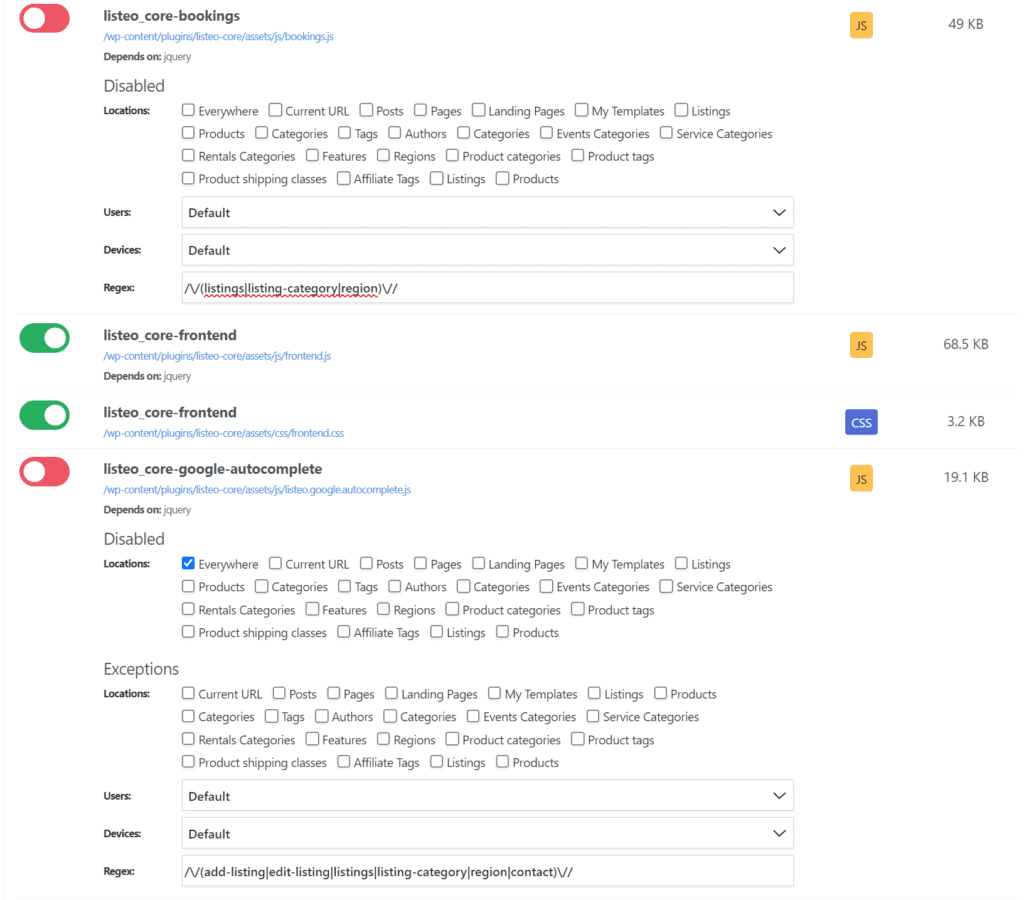
The Complexity of Manual Unloading
The manual route to script and style management is an laborious task that demands a deep dive into each enqueued file. Are you prepared to examine potentially hundreds of scripts and styles, read all their code, and determine their utility? Fortunately, we've done this laborious work for you. We've analyzed each script and style loaded by the Listeo theme, its accompanying plugins and most other popular plugins you may use to know precisely what's needed and where.
The Cost of DIY or Outsourcing
Embarking on this complex task yourself or hiring a separate developer could be costly in terms of both time and money. The developer would need to familiarize themselves with Listeo theme, plugins, and customizations—a time-consuming and potentially expensive endeavor.
By leveraging our specialized knowledge, we provide a streamlined, cost-effective solution to one of WordPress' most chronic issues—inefficient script and style management.
Conditional JavaScript Defer and Delay
Optimizing your website's frontend performance is an ongoing challenge. After addressing the removal of redundant JS and CSS on specific pages, it's time to focus on optimizing the remaining scripts that still slow down the browser. One effective technique employed by popular WordPress speed optimization plugins is to load JS deferred and delay JavaScript execution.
Understanding JavaScript Defer and Delay
Before diving into the specifics of optimization, it's crucial to understand what these techniques entail:
Defer JavaScript Loading: When you defer a JS script, you instruct the browser to continue parsing the HTML of the page without waiting for the script to load. Only after the parsing is complete will the deferred scripts start loading. This process significantly speeds up the time it takes for the initial content of your page to load, known as the First Contentful Paint.
- Delay JavaScript Execution: This technique takes deferring a step further by delaying the execution of scripts until a user interacts with the page (e.g., scrolling, clicking, or moving the mouse). It’s similar to the concept of LazyLoad, but for JavaScript files. Delaying JavaScript execution can improve several performance metrics and get to the A level of frontend speed, but most importantly, make your site feel faster since the browser doesn't have to execute js files before they are really needed.
What Speed plugins offer?
While many plugins provide both Load JS deferred and Delay JS execution, it's not just a matter of toggling a switch. Specific scripts need to be excluded from these optimizations to avoid degrading performance and usability. For instance, delaying all JS files execution can lead to a scenario where nothing appears on the page until the user interacts with it, which can be a worse user experience than not using the feature at all.
The Expertise Required for Conditional Optimization
Identifying which scripts to defer or delay requires a deep understanding of your site's JavaScript code. You must know the purpose of each script, its dependencies, and the correct sequence for loading. Years of optimization experience with WordPress and Listeo have equipped us with the knowledge to identify scripts that can be safely deferred or delayed without compromising the user experience.
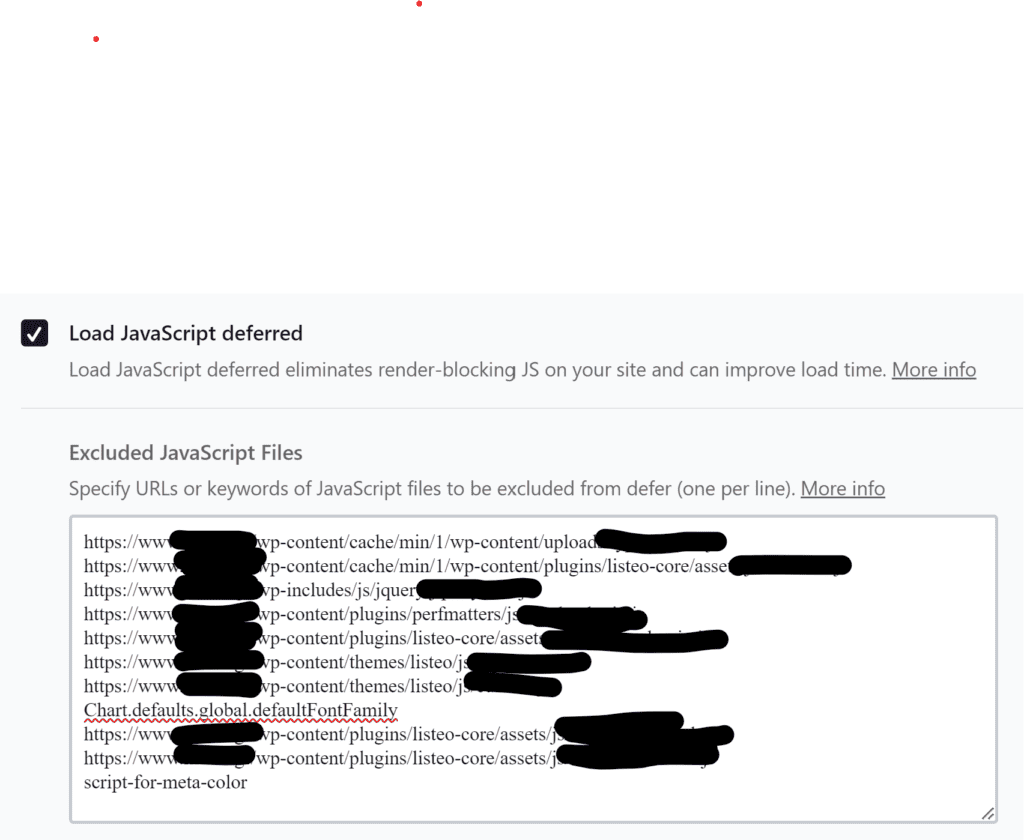
Conditional Optimization: Tailored Solutions
General-purpose speed plugins lack the ability to conditionally delay scripts. To address this, we've developed a Listeo-specific WP Rocket x Listeo plugin. Utilizing WP Rocket's developer tools, this plugin introduces the ability to delay scripts on specific pages only.
For instance, Google Maps JavaScript files which are notably large and can hinder frontend speed by adding over 200KB to every page. We've engineered the plugin to conditionally load and delay these scripts: on pages like single listings, where the map is below the initial viewport, Google Maps scripts are delayed speeding up page rendering. Conversely, on layouts where the map is immediately visible, like the half map-half listings or contact page, Google Maps scripts are not delayed, ensuring instant interactivity. This approach optimizes performance without compromising functionality.
Optimized Handling of Third-Party Tracking Scripts
Third-party tracking scripts like Google Tag Manager, Google Analytics, Google Ads scripts, Meta Pixel, and various conversion pixels are substantial in size and can significantly compromise browser performance if not managed correctly. Simply delaying these scripts the same way as your local site scripts, can lead to performance bottlenecks, as a crowd of scripts executing at the moment of first user interaction can overwhelm devices, causing temporary unresponsiveness. To avoid this, we strategically delay scripts that aren't immediately necessary, particularly those weighty third-party tracking scripts. This approach not only preserves the responsiveness of your site, particularly on weaker mobile devices, but also smartly sections your analytics. By introducing a slight delay before loading these scripts, we ensure that we're capturing data from genuinely interested users, filtering out those who leave quickly and aren't your ideal audience. This method enhances user experience and ensures more accurate targeting and analytics.
In conclusion, navigating the complexities of JavaScript loading is a complex endeavor, demanding a thorough knowledge of the purpose of each script and its influence on your website's performance. Our expertise, coupled with the capabilities of our custom WP Rocket x Listeo plugin, ensures that this understanding is seamlessly translated into concrete speed enhancements for your Listeo site. For users aiming to elevate their Listeo site's speed while maintaining full functionality, our solution is a no-brainer.
Code Optimization
Prioritizing Critical Scripts and Styles
In our quest for optimal performance, we investigate further into the script and style loading. Listeo, by default, uses the enqueue action to load scripts and styles in a predetermined sequence. However, there's room for enhancement. By rearranging the loading order, we prioritize the most crucial scripts and styles, ensuring they're loaded first.
For instance, CSS such as Font Awesome and Simple Line Icons, which are not critical for the initial rendering, are strategically sequenced after the main style.css. These kinds of adjustments ensure that the most crucial styles are loaded first, enhancing the perceived performance and the actual speed of the site. Similarly, for JavaScript, we've adjusted the loading sequence so that vital scripts are placed in the head, while less critical ones are transferred to the footer. Although the performance gains might be modest compared to JS defer and delay tactics, this optimization ensures that important functionalities are ready to go as soon as possible.
Removing Redundant Code
The second facet of our code optimization strategy involves a detailed review and trimming of CSS and JS files. Tools specifically designed to identify and eliminate redundant or duplicate CSS code are employed to slim down stylesheets. For JavaScript, our focus is on removing code that's rendered obsolete by your site's specific configurations. Take Listeo's listeo.big.leaflet.min.js for instance. It contains code catering to various mapping services like Mapbox, Bing Maps, Thunderforest, OpenStreetMaps and more. If your site exclusively uses Google Maps, all the code relating to alternative mapping services is extra. By surgically removing these irrelevant sections, we can reduce file sizes.
Tailored Optimization According to Budget and Needs
Our approach to code optimization is not one-size-fits-all. We understand that every site has its unique requirements and budgetary constraints. Therefore, we offer a tailored optimization service, focusing on areas that provide the most significant performance uplift for your investment. Beyond CSS and JS, we'll identify and address other potential bottlenecks, crafting a customized solution that aligns with your goals and resources.
Improve Server Response Time
Lower Time to First Byte
When it comes to optimizing a website for speed, frontend techniques are often the first to be implemented. They are touchable and their effects are immediately noticeable. However, even the most polished frontend can be undermined by a lagging backend. One key metric that brings this issue to light is Time to First Byte (TTFB) or Server Response Time, a critical factor often highlighted in tools like Google PageSpeed Insights and GTmetrix.
TTFB measures the duration from a user's request to the moment the first byte of the page is received by the browser. It's a reflection of the server's speed in processing a request and delivering the page content. A high TTFB can negate all frontend optimization efforts, making the page appear slow despite a well-optimized frontend.
Understanding TTFB and Its Impact
TTFB comprises three main components:
1. Sending the HTTP request: This includes DNS lookup, user's network speed, distance to the server, and any connection interruptions.
2. Processing the request: The server processes the request, which may involve starting processes, making database calls, running scripts, and communicating with other network systems.
3. Sending back the first byte: The server's network speed and the user's internet connection play a role here.
TTFB is not just a measure of page speed; it's an indicator of your site's responsiveness. It's a controllable metric that can significantly enhance your site's performance and user experience. Google suggests a TTFB under 200 ms and marks anything over 600ms as a fail in its Lighthouse audit.
Prioritizing Backend Speed Optimization
Optimizing for a low TTFB goes beyond selecting a fast web host or a more substantial server. It involves a deep dive into backend optimization, which is a complex and extensive topic in itself. It's essential to explore every aspect of your backend processes through the right Benchmarks, from database optimization to PHP script execution, to shave off those critical milliseconds from your TTFB.
Linking Frontend and Backend Optimization
Our agency recognizes that frontend and backend performance are closely interlinked. While this portfolio spotlights frontend speed optimization, it's crucial to address backend processes for comprehensive improvements. Backend optimization is a direct catalyst for frontend performance enhancements, ensuring your website isn't just superficially fast but genuinely swift at its core.
We answer your most asked Questions.
How are you sure which js and css can be disabled or delayed without affecting my site's functionality?
Through years of experience working with WordPress and the Listeo theme, we've developed a deep understanding of the dependencies and functions of various scripts and styles. While the core functionality of Listeo sites may be similar, we understand that each site is unique due to the use of different plugins and customizations. Before we consider unloading any unrecognized script or style, we precisely study its code to understand its purpose, dependencies, and the contexts in which it's needed. This careful analysis allows us to make informed decisions about optimization, ensuring that your site retains full functionality while benefiting from enhanced performance.
What level of speed optimization can I expect within my budget?
We approach each site as a unique project, with its own set of specifications, functionalities, and plugins, which means there's no one-size-fits-all solution to speed optimization. We conduct comprehensive benchmarks to identify bottlenecks and determine the most effective enhancements. We're ready to assist or delve into deeper optimizations as needed. The extent and depth of the optimization we undertake are directly correlated to your budget, prioritizing the most impactful optimizations for tighter budgets and offering comprehensive, in-depth refinement for those with more resources. Our commitment is to provide the highest level of improvement your budget allows, ensuring every dollar contributes to a noticeably faster and more efficient site.
Can you guarantee a specific page speed score after optimization?
The aim of our optimization process is not to chase scores set by benchmarking tools, but rather to provide the best possible user experience through improved site speed. GTMetrix and Pagespeed Insights are just tools—they're not the end goal. What we do guarantee is a significant improvement in site speed. Regardless of your site's starting point, whether it's already fast or sluggish, we'll elevate its performance to a new level that aligns with your budget. For example, we worked on a large site with over 60 plugins that was initially so slow it wouldn't even register on these benchmarks, meaning below F and 30. After applying our foundational Part 1 optimizations, we improved it to a C and around 60 on Pagespeed Insights, a significant leap forward. By the end of our comprehensive optimization process, the site consistently achieved A ratings with 98+ scores on these tools. The same can happen for your site too!
What is the most important optimization step you've discussed?
It's difficult to isolate a single step as the 'most important' because each plays a vital role. Think of it like building a house; you need a solid foundation before you can add the roof. A fast server, or a good caching plugin, for example, is like the foundation. It's essential for quick loading times for all visitors. The advanced tactics in Part 2 are like the roof and walls—they give the final shape to your site's performance, making it truly stand out. Our guidance avoids redundant tips found elsewhere, focusing instead on impactful strategies. Remember, the right sequence is crucial: we'll help you get the basics right, like a good hosting service, effective caching, and a CDN. Then we move to advanced customizations based on your budget. Our approach ensures a balanced and comprehensive speed optimization journey, from the ground up.
Want this for your own Listeo site?
Fill out the form below and let’s discuss how we can tailor this feature to meet your specific needs. Take your Listeo site to the next level!
Amplify your Listeo site further
Discover related portfolio works that can further elevate the Listeo platform user experience.


